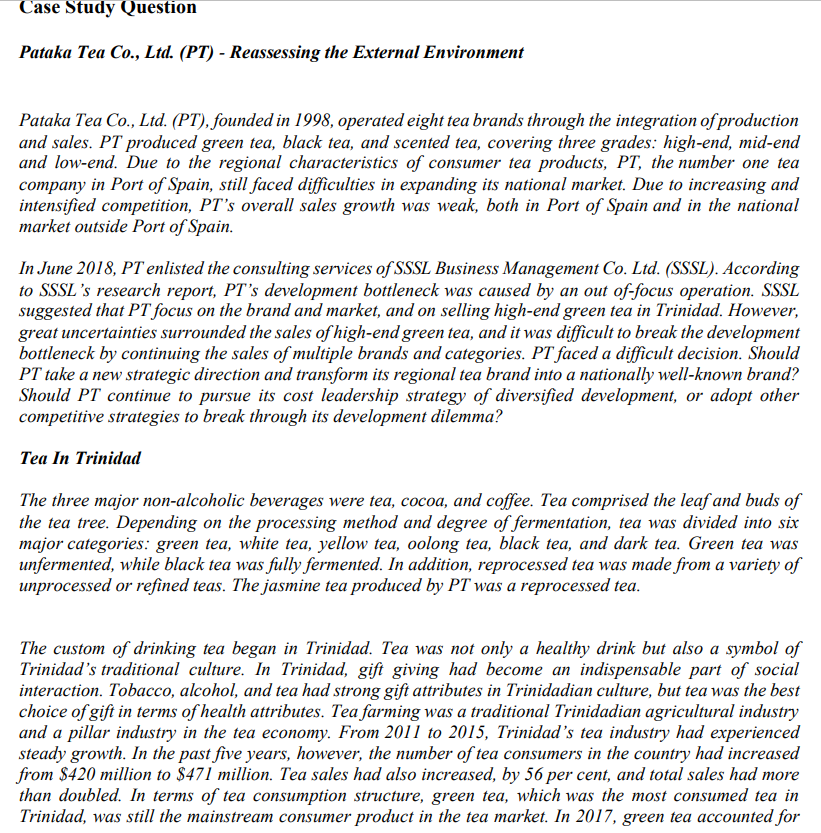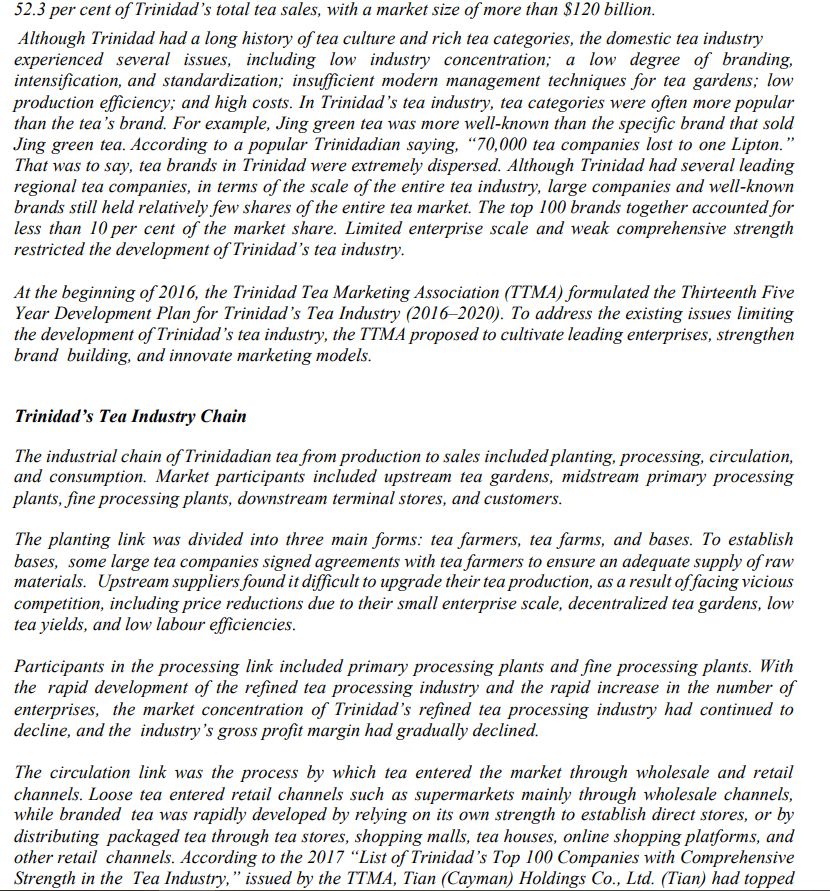Must be 2000-2500 words Case Study Question The entire case study cannot be submitted, so I attached the title and the questions to be answered. I will submit the same questions with the rest of the case study. The case study is based on an article about Pataka Tea Co., Ltd. (PT) - Reassessing the External Environment. Assignment Questions As of May 2018, what challenges had PT faced in recent years? Assess the factors in the internal and external environment that led to those challenges? Analyze the industry competition conditions that PT faced. Identify the key external factors that affected PT’s strategic decision. Develop a SWOT Analysis for PT to help King develop his strategy. Indicate how each of elements from the four (4)components from your SWOT, can be used to enhance PT’s competitive advantage. Each component of your SWO must have at least three (3) elements If you were Phillip King, chairman of PT, what recommendations – at least four (4), would you make to improve company performance and address the challenges you outlined in question 1. Provide clear justifications for your reasons.
Must be 2000-2500 words Case Study Question The entire case study cannot be submitted, so I attached the title and the questions to be answered. I will submit the same questions with the rest of the case study. The case study is based on an article about Pataka Tea Co., Ltd. (PT) - Reassessing the External Environment. Assignment Questions As of May 2018, what challenges had PT faced in recent years? Assess the factors in the internal and external environment that led to those challenges? Analyze the industry competition conditions that PT faced. Identify the key external factors that affected PT’s strategic decision. Develop a SWOT Analysis for PT to help King develop his strategy. Indicate how each of elements from the four (4)components from your SWOT, can be used to enhance PT’s competitive advantage. Each component of your SWO must have at least three (3) elements If you were Phillip King, chairman of PT, what recommendations – at least four (4), would you make to improve company performance and address the challenges you outlined in question 1. Provide clear justifications for your reasons.
Purchasing and Supply Chain Management
6th Edition
ISBN:9781285869681
Author:Robert M. Monczka, Robert B. Handfield, Larry C. Giunipero, James L. Patterson
Publisher:Robert M. Monczka, Robert B. Handfield, Larry C. Giunipero, James L. Patterson
ChapterC: Cases
Section: Chapter Questions
Problem 5.3SD: Scenario 4 Sharon Gillespie, a new buyer at Visionex, Inc., was reviewing quotations for a tooling...
Related questions
Question
Must be 2000-2500 words
Case Study Question
The entire case study cannot be submitted, so I attached the title and the questions to be answered. I will submit the same questions with the rest of the case study.
The case study is based on an article about Pataka Tea Co., Ltd. (PT) - Reassessing the External Environment.
Assignment Questions
- As of May 2018, what challenges had PT faced in recent years? Assess the factors in the internal and external environment that led to those challenges?
- Analyze the industry competition conditions that PT faced. Identify the key external factors that affected PT’s strategic decision.
- Develop a SWOT Analysis for PT to help King develop his strategy. Indicate how each of elements from the four (4)components from your SWOT, can be used to enhance PT’s competitive advantage. Each component of your SWO must have at least three (3) elements
- If you were Phillip King, chairman of PT, what recommendations – at least four (4), would you make to improve company performance and address the challenges you outlined in question 1. Provide clear justifications for your reasons.

Transcribed Image Text:Case Study Question
Pataka Tea Co., Ltd. (PT) - Reassessing the External Environment
Pataka Tea Co., Ltd. (PT), founded in 1998, operated eight tea brands through the integration of production
and sales. PT produced green tea, black tea, and scented tea, covering three grades: high-end, mid-end
and low-end. Due to the regional characteristics of consumer tea products, PT, the number one tea
company in Port of Spain, still faced difficulties in expanding its national market. Due to increasing and
intensified competition, PT's overall sales growth was weak, both in Port of Spain and in the national
market outside Port of Spain.
In June 2018, PT enlisted the consulting services of SSSL Business Management Co. Ltd. (SSSL). According
to SSSL's research report, PT's development bottleneck was caused by an out of-focus operation. SSSL
suggested that PT focus on the brand and market, and on selling high-end green tea in Trinidad. However,
great uncertainties surrounded the sales of high-end green tea, and it was difficult to break the development
bottleneck by continuing the sales of multiple brands and categories. PT faced a difficult decision. Should
PT take a new strategic direction and transform its regional tea brand into a nationally well-known brand?
Should PT continue to pursue its cost leadership strategy of diversified development, or adopt other
competitive strategies to break through its development dilemma?
Tea In Trinidad
The three major non-alcoholic beverages were tea, cocoa, and coffee. Tea comprised the leaf and buds of
the tea tree. Depending on the processing method and degree of fermentation, tea was divided into six
major categories: green tea, white tea, yellow tea, oolong tea, black tea, and dark tea. Green tea was
unfermented, while black tea was fully fermented. In addition, reprocessed tea was made from a variety of
unprocessed or refined teas. The jasmine tea produced by PT was a reprocessed tea.
The custom of drinking tea began in Trinidad. Tea was not only a healthy drink but also a symbol of
Trinidad's traditional culture. In Trinidad, gift giving had become an indispensable part of social
interaction. Tobacco, alcohol, and tea had strong gift attributes in Trinidadian culture, but tea was the best
choice of gift in terms of health attributes. Tea farming was a traditional Trinidadian agricultural industry
and a pillar industry in the tea economy. From 2011 to 2015, Trinidad's tea industry had experienced
steady growth. In the past five years, however, the number of tea consumers in the country had increased
from $420 million to $471 million. Tea sales had also increased, by 56 per cent, and total sales had more
than doubled. In terms of tea consumption structure, green tea, which was the most consumed tea in
Trinidad, was still the mainstream consumer product in the tea market. In 2017, green tea accounted for

Transcribed Image Text:52.3 per cent of Trinidad's total tea sales, with a market size of more than $120 billion.
Although Trinidad had a long history of tea culture and rich tea categories, the domestic tea industry
experienced several issues, including low industry concentration; a low degree of branding,
intensification, and standardization; insufficient modern management techniques for tea gardens; low
production efficiency; and high costs. In Trinidad's tea industry, tea categories were often more popular
than the tea's brand. For example, Jing green tea was more well-known than the specific brand that sold
Jing green tea. According to a popular Trinidadian saying, "70,000 tea companies lost to one Lipton."
That was to say, tea brands in Trinidad were extremely dispersed. Although Trinidad had several leading
regional tea companies, in terms of the scale of the entire tea industry, large companies and well-known
brands still held relatively few shares of the entire tea market. The top 100 brands together accounted for
less than 10 per cent of the market share. Limited enterprise scale and weak comprehensive strength
restricted the development of Trinidad's tea industry.
At the beginning of 2016, the Trinidad Tea Marketing Association (TTMA) formulated the Thirteenth Five
Year Development Plan for Trinidad's Tea Industry (2016-2020). To address the existing issues limiting
the development of Trinidad's tea industry, the TTMA proposed to cultivate leading enterprises, strengthen
brand building, and innovate marketing models.
Trinidad's Tea Industry Chain
The industrial chain of Trinidadian tea from production to sales included planting, processing, circulation,
and consumption. Market participants included upstream tea gardens, midstream primary processing
plants, fine processing plants, downstream terminal stores, and customers.
The planting link was divided into three main forms: tea farmers, tea farms, and bases. To establish
bases, some large tea companies signed agreements with tea farmers to ensure an adequate supply of raw
materials. Upstream suppliers found it difficult to upgrade their tea production, as a result of facing vicious
competition, including price reductions due to their small enterprise scale, decentralized tea gardens, low
tea yields, and low labour efficiencies.
Participants in the processing link included primary processing plants and fine processing plants. With
the rapid development of the refined tea processing industry and the rapid increase in the number of
enterprises, the market concentration of Trinidad's refined tea processing industry had continued to
decline, and the industry's gross profit margin had gradually declined.
The circulation link was the process by which tea entered the market through wholesale and retail
channels. Loose tea entered retail channels such as supermarkets mainly through wholesale channels,
while branded tea was rapidly developed by relying on its own strength to establish direct stores, or by
distributing packaged tea through tea stores, shopping malls, tea houses, online shopping platforms, and
other retail channels. According to the 2017 "List of Trinidad's Top 100 Companies with Comprehensive
Strength in the Tea Industry," issued by the TTMA, Tian (Cayman) Holdings Co., Ltd. (Tian) had topped
Expert Solution
This question has been solved!
Explore an expertly crafted, step-by-step solution for a thorough understanding of key concepts.
Step 1: Introducing the case:
VIEWStep 2: 1. Industry Competition Conditions Faced by PT & Factors in the Internal and External Environment:
VIEWStep 3: 2. Analysis of Industry Competition Conditions and Key External Factors:
VIEWStep 4: 3. Outline the SWOT Analysis for PT:
VIEWStep 5: 4. Outline the Recommendations for PT:
VIEWSolution
VIEWStep by step
Solved in 6 steps

Recommended textbooks for you

Purchasing and Supply Chain Management
Operations Management
ISBN:
9781285869681
Author:
Robert M. Monczka, Robert B. Handfield, Larry C. Giunipero, James L. Patterson
Publisher:
Cengage Learning

Purchasing and Supply Chain Management
Operations Management
ISBN:
9781285869681
Author:
Robert M. Monczka, Robert B. Handfield, Larry C. Giunipero, James L. Patterson
Publisher:
Cengage Learning